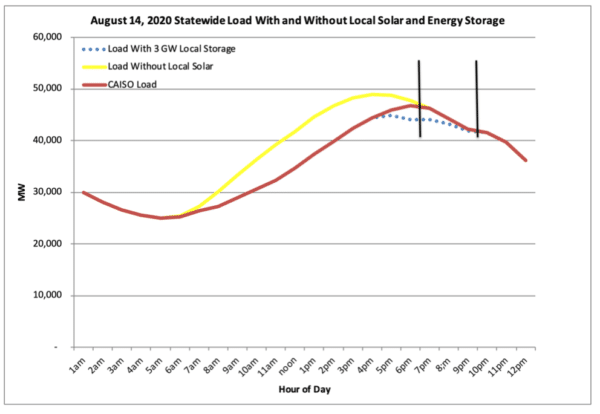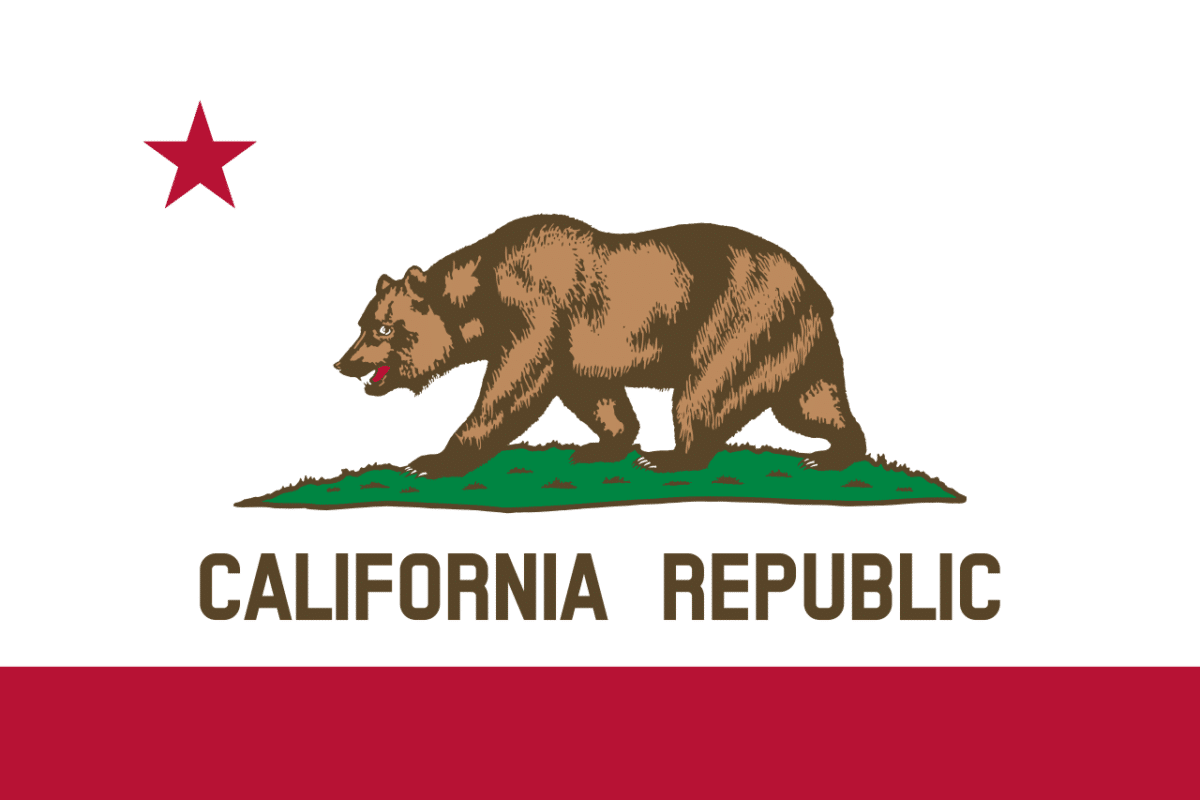Some headlines and quotes from experts erroneously lay blame for the recent California blackouts on solar energy. This couldn’t be further from the truth. In fact, solar energy technologies did exactly what solar energy can be relied upon to do: generate tons of energy on hot sunny days! In fact, if not for all the solar power on the grid this past weekend, the California outages would have likely lasted far longer and been more widespread.
The blame should be laid at the feet of the fossil fuel industry, which had power plants fail to produce when they were most needed. The idea of building more peaker plants, or prolonging the life of the old plants, is a recipe for more energy outages in the months and years ahead.
Moving beyond blame, what is really needed is more solar energy, not less, combined with more batteries to cover evening peak. California is not doing enough on this front.
The chart below based on August 14, 2020 CALISO data demonstrates this point.
August 14, 2020 statewide load with and without local solar and energy storage

Since the last electricity crisis in 2001, California has built 9 gigawatts of local solar energy at over a million customer sites throughout the state. Without those systems helping lower peak demand on hot summer days, such as August 14, 2020, the strain on the state’s electric grid would have been much greater, as portrayed in the yellow line of actual total energy usage. The red line depicts CAISO’s visibility on electricity demand. Because the electricity generated by behind-the-meter solar systems is consumed entirely on local circuits, CAISO data does not reflect the contribution of local solar and storage to the state’s energy picture.
If California builds 3 GW of additional energy storage systems at customer locations that can be dispatched during grid shortages, it would further trim evening peak needs. This is shown in the figure as the dotted blue line. CALSSA estimates that California can achieve this level of build-out within the next five years with state policies.
What is interesting to those of us who were around for the previous rolling blackouts is that California’s electricity needs still peak in the late afternoon, around 3 p.m. All the solar we’ve installed on the grid via Net Energy Metering-interconnected systems has had a significant effect of lowering peak demand, and shifting it into the evening hours. Because CALISO only manages the centralized grid and no other energy regulator (CEC or CPUC) has stepped in to communicate the complete picture, the public is left thinking Californians use more electricity at 6 p.m. than we do at 3 p.m. The problem with this is of course it gives the impression that solar energy is either not doing its job or it is irrelevant to today’s energy needs (or both!). Nothing could be further from the truth. We do, of course, have an evening peak which requires more energy storage, not more fossil plants.
***
Bernadette Del Chiaro is executive director of the California Solar & Storage Association.
The views and opinions expressed in this article are the author’s own, and do not necessarily reflect those held by pv magazine.
This content is protected by copyright and may not be reused. If you want to cooperate with us and would like to reuse some of our content, please contact: editors@pv-magazine.com.








You do not mention that solar power has been impacted by the recent cloud cover on the very hot days we have had in California. It is very unusual for this time of year. This also played into the demand for more fossil fuel plants to be dispatched at times they normally would not be during the day. It is not so much that solar was to blame but it was impacted by the weather.
Um, cloud cover and solar power generation are directly linked, so there’s a direct cause and effect. So, yes, intermittent solar power is part of the problem. As for the article, there’s no way that storage is going to solve this in the next 3 years. so CA can stand ready for suffering through the bad choices imposed by the government.
“…and no other energy regulator (CEC or CPUC) has stepped in to communicate the complete picture, the public is left thinking Californians use more electricity at 6 p.m. than we do at 3 p.m. The problem with this is of course it gives the impression that solar energy is either not doing its job or it is irrelevant to today’s energy needs (or both!). Nothing could be further from the truth.”
This is so maddening. It makes me wonder – is a lot of this simply due to the people who’s pockets are being lined by dirty fossil fuels? On the other hand, I’m confident that, given time, the truth and economics will win and renewables will prevail.
No, what is needed is the ability to shift consumption to match demand rather than paying extra for storage to shift production to when it’s consumed.
Shifting consumption adds little cost, so the power is more affordable, and given that Californians are paying 50% more than the rest of the country, they need to save whatever they can.
You cannot finance these plants based on intermittent use. We told you that twenty years ago. So you fired the naysayers and suppressed criticism and now you’re making up lies. If alt energy worked it, wouldn’t be alt energy.
Speaking of naysayers, I remember when myopic people were writing books about how cell phones would never make sense economically and would be a miserable failure. Certain people are saying the same about renewable energy now. But technology marches on and rolls right over them.
Does California have any residents who actually have normal thought processes? For one, this article is incorrect at it’s base. Not only that but the biased view is typical of the liberal views of the average Californian. Which in itself shows how out of touch with reality that it really is.
It amazes me how a state can be literally broke and still drive businesses out while trying to run a socialist system of government that continues to fail them.
If only there was a company in California, like a car maker who cranks out more battery capacity than anybody in the world, who could easily sell the state industrial sized battery banks to shift the solar power to handle the rest of the day.
I am baffled how the author concluded that California’s peak electrical use occurs at 3 PM. All of the available statistics show the peak, in the summer at least, at or near 6 PM, with the peak for non-renewables occurring around 7 PM. Please refer to the caiso.com web site for extensive charts.
Look at the yellow curve in the graph which shows that total solar helped to carry the actual peak load at about 4 PM on Aug 14. The yellow curve includes Local Solar that is not in the CAISO data.
Yes, I see that curve. It does seem to peak on the graphic at 4 PM rather than 3 PM, but perhaps that’s being too picky. My difficulty is: where do the numbers come from to derive that yellow curve? I see various amounts of rooftop solar in my neighborhood, with many of the problems of rooftop solar (trees shading the PV panels, bad angles including panels on north-facing roofs, not been washed for years, oh it’s endless) so if the yellow curve is just a guess based on the installed kWh of rooftop solar then it’s likely a WAG (worryingly ambitious guess.)
No mention of the loss of wind which was 2x the loss of nat gas
“The California Independent System Operator (ISO) declared a Stage 3 Electrical Emergencyat 6:28 p.m. on Saturday, Aug. 15, due to increased electricity demand,the unexpected loss of a 470-megawatt (MW) power plant,and loss of nearly 1,000 MW of wind power”
http://www.caiso.com/Documents/ISORequestedPowerOutagesFollowingStage3EmergencyDeclarationSystemNowBeingRestored.pdf
It looks like this take Bernadette hasn’t aged well. California is still suffering with rolling blackouts, and Gavin Newsome is out talking about how he is saving Diablo Canyon NPP to provide needed power to California. Gavin Newsome was the one who forced PG&E to retire Diablo Canyon NPP early and to replace it with renewable energy. That’s worked out pretty well for him and California. As humanity gets more advanced, we still don’t seem to have found a way to keep the least intelligent among us from becoming our leaders.